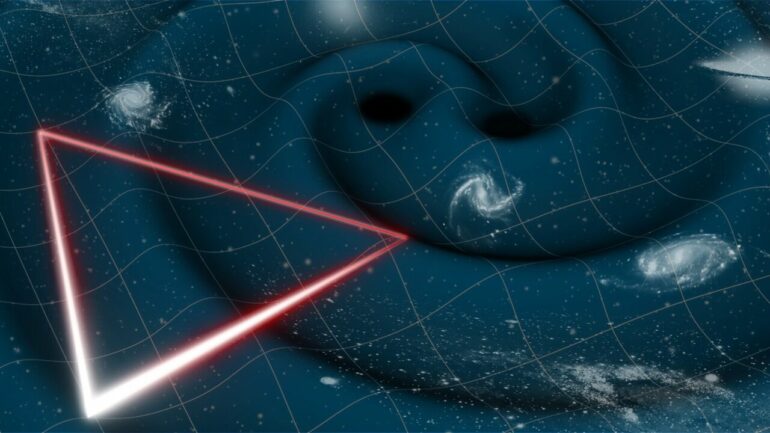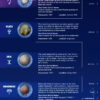The background noise of gravitational waves from orbiting white dwarf stars will be stronger than the noise from binary black holes. This is what two Dutch master’s students and their supervisor predict in two papers in anticipation of the LISA space mission. Until now, that mission did not account for noisy white dwarfs. Fortunately, the noise can be filtered out and even provide new information.
The papers, titled “On the uncertainty of the White Dwarf Astrophysical Gravitational Wave Background” and “Likelihood of white dwarf binaries to dominate the astrophysical gravitational wave background in the mHz band” have been published in Astronomy & Astrophysics.
LISA, the Laser Interferometer Space Antenna, is scheduled for launch by the European Space Agency (ESA) in the mid-2030s. Among other things, the Netherlands is building LISA’s “eyes,” software, guidance mechanism and readout electronics.
LISA will measure gravitational waves from compact binary stars, double white dwarfs, supermassive merging black holes and other exotic objects in the universe. As a byproduct, LISA will also pick up background noise from thousands of billions of black holes that merged long ago.
Gijs Nelemans is an astronomer at Radboud University (Nijmegen, the Netherlands). He is involved in the Dutch contribution to LISA. Together with now graduated master students Seppe Staelens and Sophie Hofman, he developed models to see if the background noise of white dwarfs could be captured in the same way as the background noise of black holes.
Staelens, who came to Nijmegen as an exchange student from Leuven (Belgium) and is now a Ph.D. student at Cambridge (UK), started with simple models. Hofman, who has just graduated and is doing a traineeship in industry, then expanded the models.
The models showed that the background noise from white dwarfs is stronger than that from black holes. “Our supervisor thought that LISA would never be able to detect the collective signal from white dwarfs,” says Staelens. “And now our models show that the white dwarfs are dwarfing the black holes. Ha!”
Astronomers see the background noise of white dwarfs as an opportunity to study the evolution of stars like our sun in distant galaxies. “With telescopes you can only study white dwarfs in our own Milky Way, but with LISA we can listen to white dwarfs from other galaxies,” says Nelemans.
“Moreover, in addition to the background noise of black holes and the noise of white dwarfs, perhaps other exotic processes from the early universe can be detected.”
Hofman adds, “I think it’s really cool that with my master’s research we’re contributing to the expected discovery of such an important mission as LISA.”
More information:
Sophie Hofman et al, On the uncertainty of the White Dwarf Astrophysical Gravitational Wave Background, arXiv (2024). DOI: 10.48550/arxiv.2407.10642. Accepted for publication in Astronomy & Astrophysics.
Seppe Staelens et al, Likelihood of white dwarf binaries to dominate the astrophysical gravitational wave background in the mHz band, Astronomy & Astrophysics (2023). DOI: 10.1051/0004-6361/202348429
Provided by
Netherlands Research School for Astronomy
Citation:
Dutch students warn space mission of noisy white dwarfs (2024, October 16)



